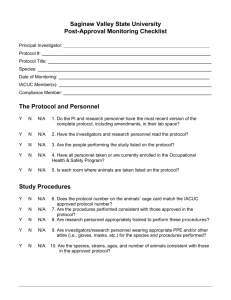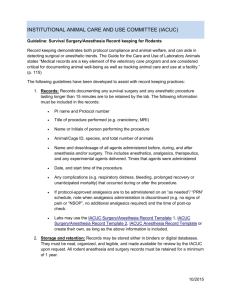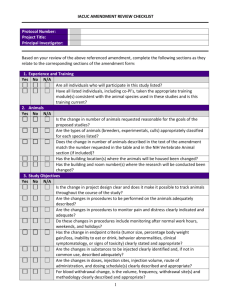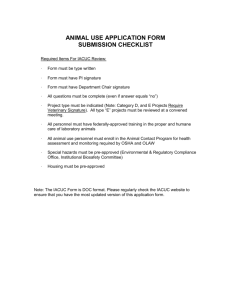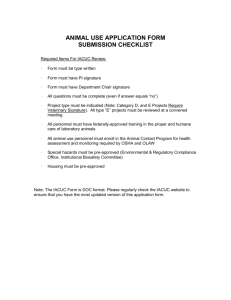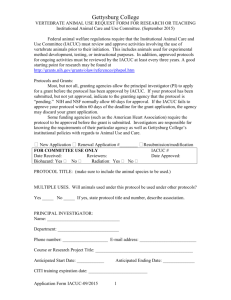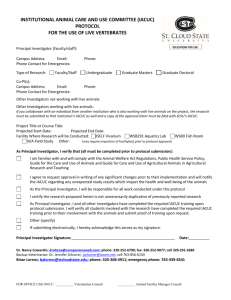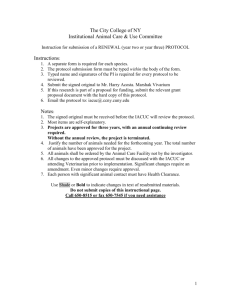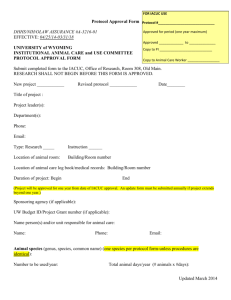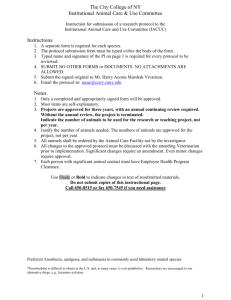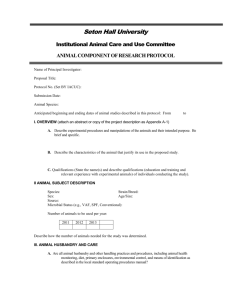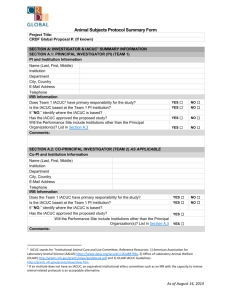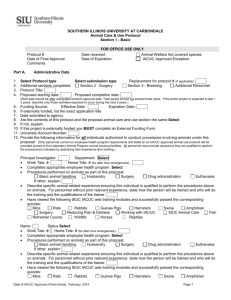institutional animal care and use committee (iacuc)
advertisement
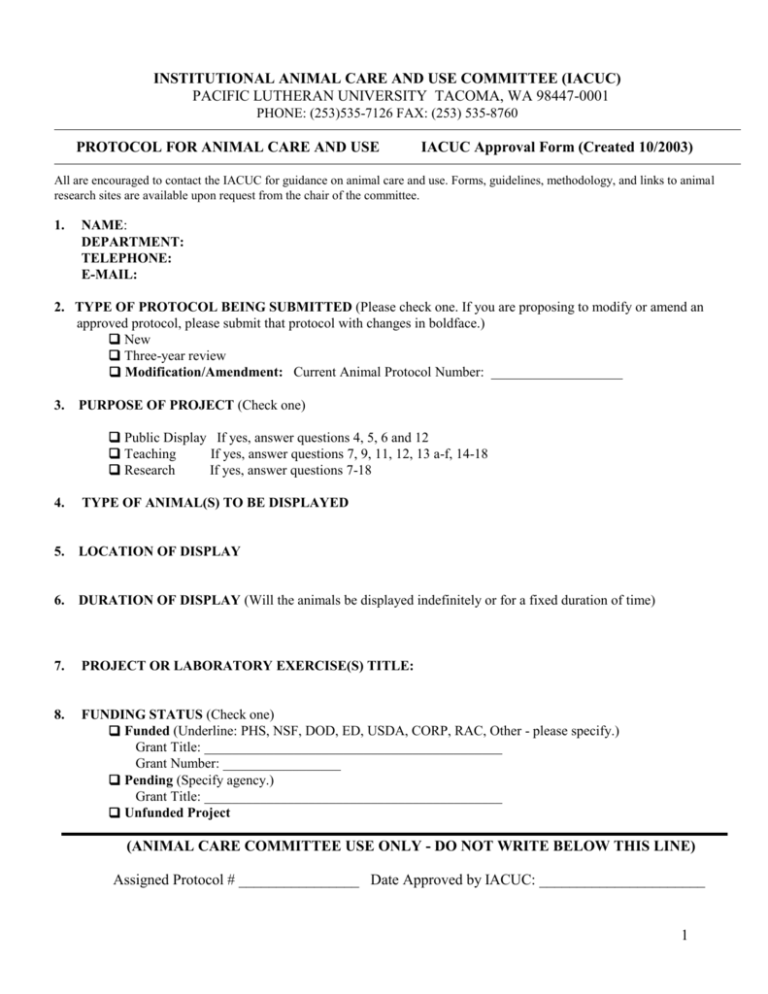
INSTITUTIONAL ANIMAL CARE AND USE COMMITTEE (IACUC) PACIFIC LUTHERAN UNIVERSITY TACOMA, WA 98447-0001 PHONE: (253)535-7126 FAX: (253) 535-8760 PROTOCOL FOR ANIMAL CARE AND USE IACUC Approval Form (Created 10/2003) All are encouraged to contact the IACUC for guidance on animal care and use. Forms, guidelines, methodology, and links to animal research sites are available upon request from the chair of the committee. 1. NAME: DEPARTMENT: TELEPHONE: E-MAIL: 2. TYPE OF PROTOCOL BEING SUBMITTED (Please check one. If you are proposing to modify or amend an approved protocol, please submit that protocol with changes in boldface.) New Three-year review Modification/Amendment: Current Animal Protocol Number: ___________________ 3. PURPOSE OF PROJECT (Check one) Public Display If yes, answer questions 4, 5, 6 and 12 Teaching If yes, answer questions 7, 9, 11, 12, 13 a-f, 14-18 Research If yes, answer questions 7-18 4. TYPE OF ANIMAL(S) TO BE DISPLAYED 5. LOCATION OF DISPLAY 6. DURATION OF DISPLAY (Will the animals be displayed indefinitely or for a fixed duration of time) 7. PROJECT OR LABORATORY EXERCISE(S) TITLE: 8. FUNDING STATUS (Check one) Funded (Underline: PHS, NSF, DOD, ED, USDA, CORP, RAC, Other - please specify.) Grant Title: ___________________________________________ Grant Number: _________________ Pending (Specify agency.) Grant Title: ___________________________________________ Unfunded Project (ANIMAL CARE COMMITTEE USE ONLY - DO NOT WRITE BELOW THIS LINE) Assigned Protocol # ________________ Date Approved by IACUC: ______________________ 1 Is any research related to this study being conducted at another institution or facility? No Yes If "YES", where and what capacity? 9. APPROXIMATE NUMBER, TYPE(S), AND SOURCE OF ANIMALS (Use common name and stock or strain, e.g., 155 laboratory mice, BALB/cByJ, from Jackson Laboratory. These include animals purchased or captured.) 10. WHERE WILL THE ANIMALS BE HOUSED? Preferred Location: Are there any special husbandry requirements? No Yes Explain: 11. SPECIAL CONSIDERATIONS: Is stress or prolonged restraint a necessary component of the experiment? No Yes Will animals be exposed to hazardous materials that require special animal care, containment, and disposal? No Yes Will you perform surgery? ("Surgery" includes minor surgery such as cut downs (superficial wounds used for catheter placement) and needle aspirations as well as major surgery involving penetration of a body cavity.) No Yes If "YES", describe the surgical procedure in section 16. 12. EMERGENCY NOTIFICATION DATA (Give name, telephone number and e-mail address for each person who is responsible for animal procedures or care in the principal caretakers' absence. It is required that all animals be checked at least once a day.) Name: Office telephone number: Home telephone number: E-mail address: 13. PROJECT SUMMARY AND RATIONALE (Federal regulations require that this section be written in “layman’s language.” The specialized language of grant proposals is generally not acceptable. The IACUC suggests that you write in language appropriate to an article in Scientific American. Diagrams or figures may be helpful in communicating your intentions.) a. Explain the objectives of the study or experiment (What do you expect it to achieve?) b. Explain why the study is important (Describe its relevance to human or animal health, the advancement of scientific knowledge, or the good of society.) 2 c. State how you propose to reach your goals (Briefly describe the design of the study so as to make clear how the proposed uses of animals contribute to attaining your objectives. If animals will be used in various ways, briefly describe them, and indicate how they fit into the overall design. Do this in such a way that the reader can follow the experimental career of each animal or group. For field studies, if animals in the wild will be used, describe how they will be observed, any interactions with the animals, whether the animals will be disturbed or affected and any special procedures anticipated. Indicate if Federal permits are required and whether they have been obtained. Note: Modification of your experimental design or the procedures described below in section 16 will require IACUC approval. If you can anticipate a need for modifications, you may be able to secure approval in advance by describing alternate designs and procedures in this protocol.) d. Justify the use of animals (Say why it is necessary to use animals rather than computer models, tissue cultures, data mining, etc.) e. Justify each choice of species (Explain why you have chosen the particular species you propose to use.) f. Justify the number of animals (Describe how the number of animals to be used was determined, and why that number is necessary to achieve the goals of this study. If possible, summarize this information in a table giving 1) the number of different experiments, 2) the number of groups per experiment, and 3) the number of animals per group.) g. There are Federal policies regarding documentation that reduction, replacement, and refinement (the three R’s) have been addressed. Give evidence that the study does not unnecessarily duplicate your work or the work of others. In addition, you should determine that 1) there are no non-animal alternatives available and that 2) less painful/distressful alternatives to your proposed animal use and procedures are not available or feasible. a) b) c) Databases searched: Keywords: Years searched: 14. DISTRESS/PAIN LEVEL(S): Animals scheduled for use in research, teaching, or testing must be placed in Categories A, B, C, or D depending on the anticipated pain or distress and planned relief. If your procedures fall under category C or D in the table below, please explain why alternatives to stressful or painful procedures are not possible. For each species, give the approximate percent for each categories (e.g 90% B: dosed and euthanized for tissue collection; 10% C: dosed, bled via catheter surgically placed under anesthesia and euthanized). Species % Category A % Category B % Category C % Category D Total 100% 100% 100% 100% 3 Definition of Categories of Pain: A. The research or laboratory exercise involves either no pain or potentially involves momentary, slight pain, discomfort or distress. Includes simple invasive procedures (e.g., injection, blood sampling), collection of tissues preceded by standard euthanasia, behavioral testing without stress. In field studies, includes live capture methods that provide adequate movement for the target species, the use of trap mechanisms or nets that typically do not inflict injury, and sufficient personnel to monitor traps and nets frequently. Marking of individuals is temporary or permanent and does not restrict normal activity or results in only slight pain, such as attaching arm/leg bands or temporary radio collars, tattooing, or cutting tissue such as fins, scales, shells, or claws that does not result in bleeding. B. The research or laboratory exercise potentially involves minor short-term pain, discomfort or distress which will be treated with appropriate anesthetics/analgesics. Includes terminal anesthetic surgery, minor survival surgery with anesthesia and without significant postoperative pain (e.g., biopsy or placement of subcutaneous capsules containing estrogen) and/or implantation of minor chronic catheters (e.g., femoral arterial and venous catheters, etc.) and/or short-term physical restraint (<60 minutes) of awake animals and/or induction of minor behavioral stress. In field studies, includes using sedative darts to immobilize or lassos and padded leg traps to restrain animals. Also includes electrofishing in which mortality is minimal. Marking of individuals is permanent by such methods as ear tagging or toe clipping that typically result in bleeding. Collecting small amounts of blood using standard field procedures. C. The research or laboratory exercise involves procedures potentially inducing moderate pain, discomfort or distress which will be treated with appropriate anesthetics/analgesics and/or chronic maintenance of animals with a disease/functional deficit. Includes major survival surgery with anesthesia (e.g., placement of microdialysis probes into the brain) and/or inducement of a functional deficit (e.g., inflammation induced by adjuvants used for the generation of polyclonal antibodies), and/or physical restraint (>60 minutes) of awake animals and/or induction of more than minor behavioral stress. In field studies, includes the use of kill traps or firearms when used by experienced personnel or under direct supervision. D. The research or laboratory exercise potentially involves pain, discomfort or distress (greater than that attending routine injection) which cannot or will not be alleviated through the administration of appropriate anesthetic, analgesic or tranquilizer drugs. Examples include pain research and toxicity testing where animals become moribund. 15. RECORDS & MONITORING a) State where these records will be available for inspection by the IACUC, Veterinarian, and federal officials. b) Monitoring (Describe your system for monitoring animal health and welfare.) 16. PROPOSED PROCEDURES a) Agents used (Describe any physical, chemical or biological agents that may be administered.) No Agents used. Yes, Agents used. If "YES", please complete sections on the next page. 4 Name, dose in mg/kg body weight, delivery route, and frequency of use Volumes and frequency of collection of blood and/or other body fluids, specialized restraint devices or housing, etc. Controlled Substances: If you are using controlled substances, you will need both a federal and state license. b) Surgery No Yes If "YES", please complete sections below. 1) Describe the surgical procedures. 2) State below the anesthetic agents and dosages to be used for each species. Provide a justification if you do not intend to use anesthesia. 3) How will anesthetic depth be monitored? (check at least 2) Blood Pressure/EKG Corneal and Pedal Reflexes EEG Heart rate Respiratory rate Other (specify below) c) Will muscle relaxants or paralytic drugs be used? No Yes If "YES", list the drugs and dosages in the surgical procedure. List also the criteria for monitoring anesthesia under muscle paralysis. d) Are the animals to recover from surgery? No Yes If "YES", answer 1 through 4: 1. Who will check the animals during the recovery and how often? 2. What impairment is caused by the surgery, and will the animal experience pain as a result of the surgery? 3. Postoperative Care: (a) What is the duration of survival after surgery? (b) How will the animals be monitored immediately post-operatively? (c) Will the animals be given post-operative analgesics? Yes No If "YES," answer 1 and 2 below. If not using post-operative analgesics, justify why not. 1. Agent: 2. Dose: (d) List any expected or potential post-operative complications and plans to handle them. 4. If you will be doing surgery, you must observe proper sterile technique. a. I agree to use sterile instruments at all times. Yes No b. I agree to maintain sterile conditions/field during surgery. Yes No c. I agree to prepare animals for surgery by clipping and disinfecting the skin surface using a suitable material such as Betadine. Yes No If you answered "NO", to any of the above questions you must justify the variations in compliance below: 5 e) Will the animals undergo more than one surgical procedure? No Yes If "YES", you must justify below why it is scientifically necessary to do so. 17. EUTHANASIA OR OTHER DISPOSITION OF ANIMALS If the method cited is not listed as approved in the 2000 Report of the AVMA Panel of Euthanasia, indicate scientific justification (with references, if possible). (http://www.avma.org/resources/euthanasia.pdf.) a. Method of euthanasia: b. Euthanasia drug dose in mg/kg body weight and route of administration: c. How will the remains be disposed of? Note: The IACUC encourages finding alternatives to euthanasia or “warehousing “ of healthy animals no longer participating in your study (e.g. transfer to other protocols or investigators, make available for adoption) Describe your plan, if you are willing to make live animals available after your study. 18. QUALIFICATIONS AND TRAINING (Detail the qualifications and training for each individual involved in animal handling, performing surgical procedures or performing euthanasia.) CERTIFICATION OF APPLICANT __________________________________ Signature __________ Date ______________________________________ Position Signature certifies that the above named will utilize animals in full accordance with the PHS Policy on Humane Care and Use of Laboratory Animals, USDA rules and university guidelines governing the use of live vertebrate animals for research, teaching and display purposes. It is understood that IACUC approval is valid for a period of 36 months following the date of original approval and release with annual update required and re-review for projects which continue beyond 36 months. It is further understood that if this project is to be or has been submitted for external funding the information presented on the Application form reflects, accurately, the animal use in the full grant application(s). It is the responsibility of the investigator(s) to communicate to the granting agency any changes in the research plan that may result from the IACUC review process. 6
